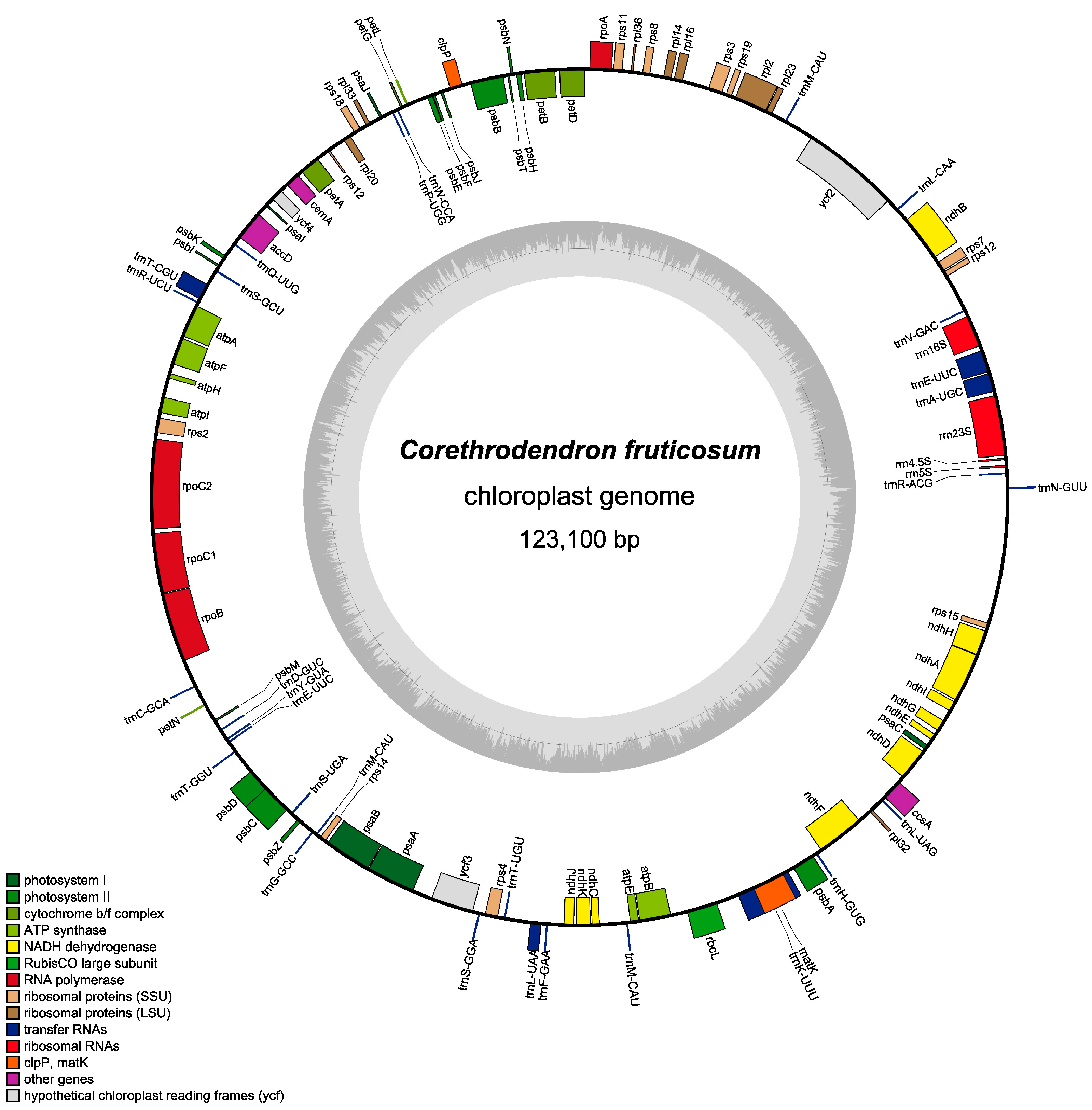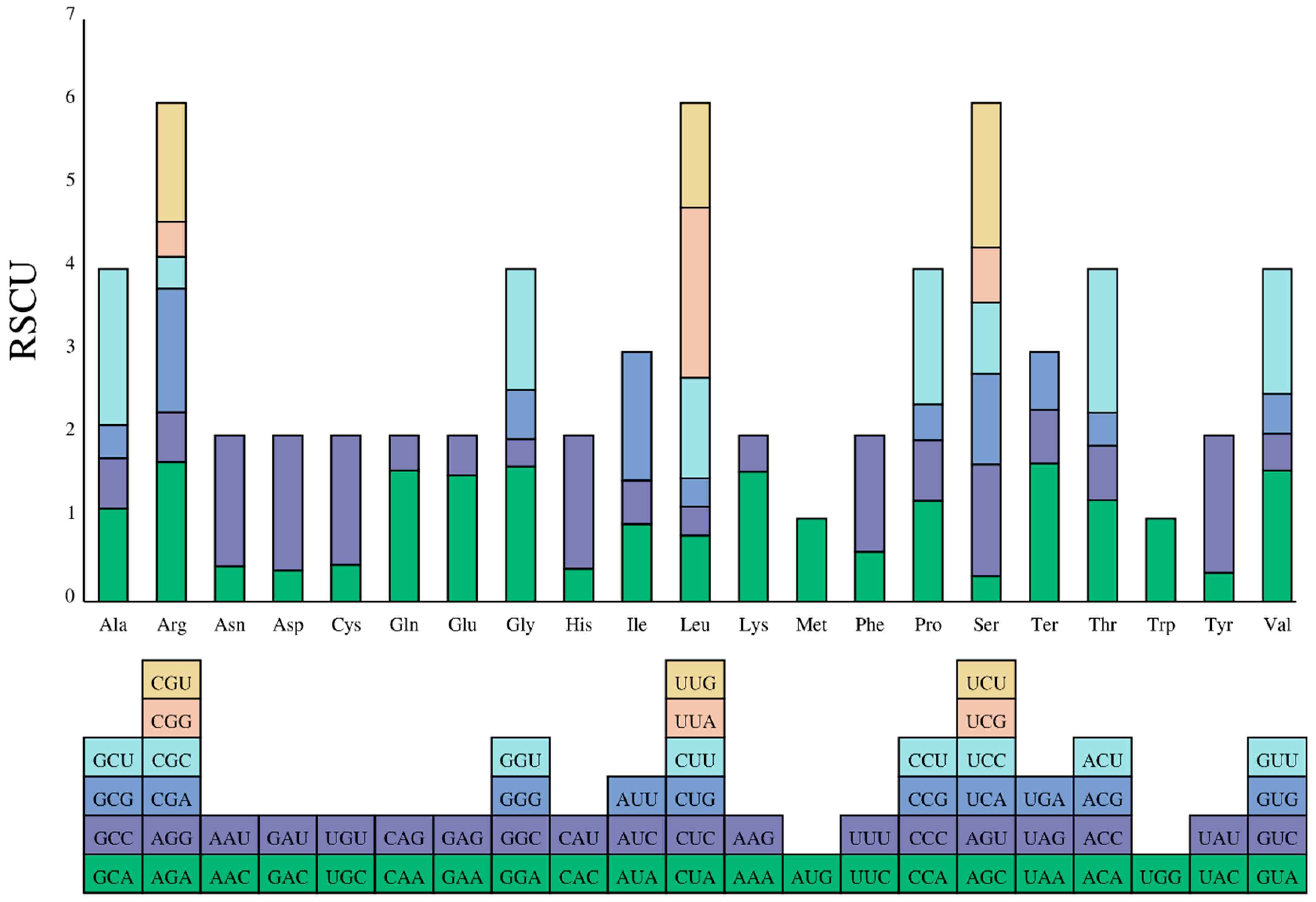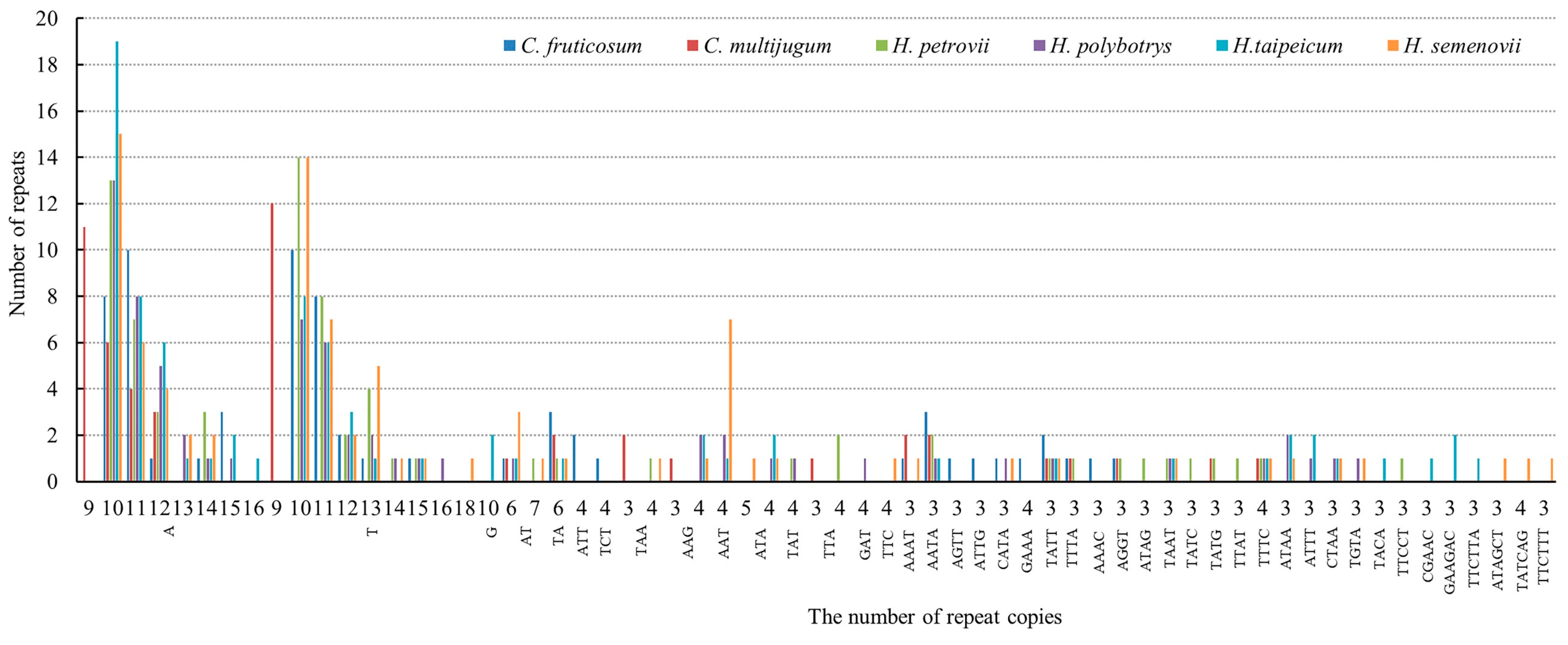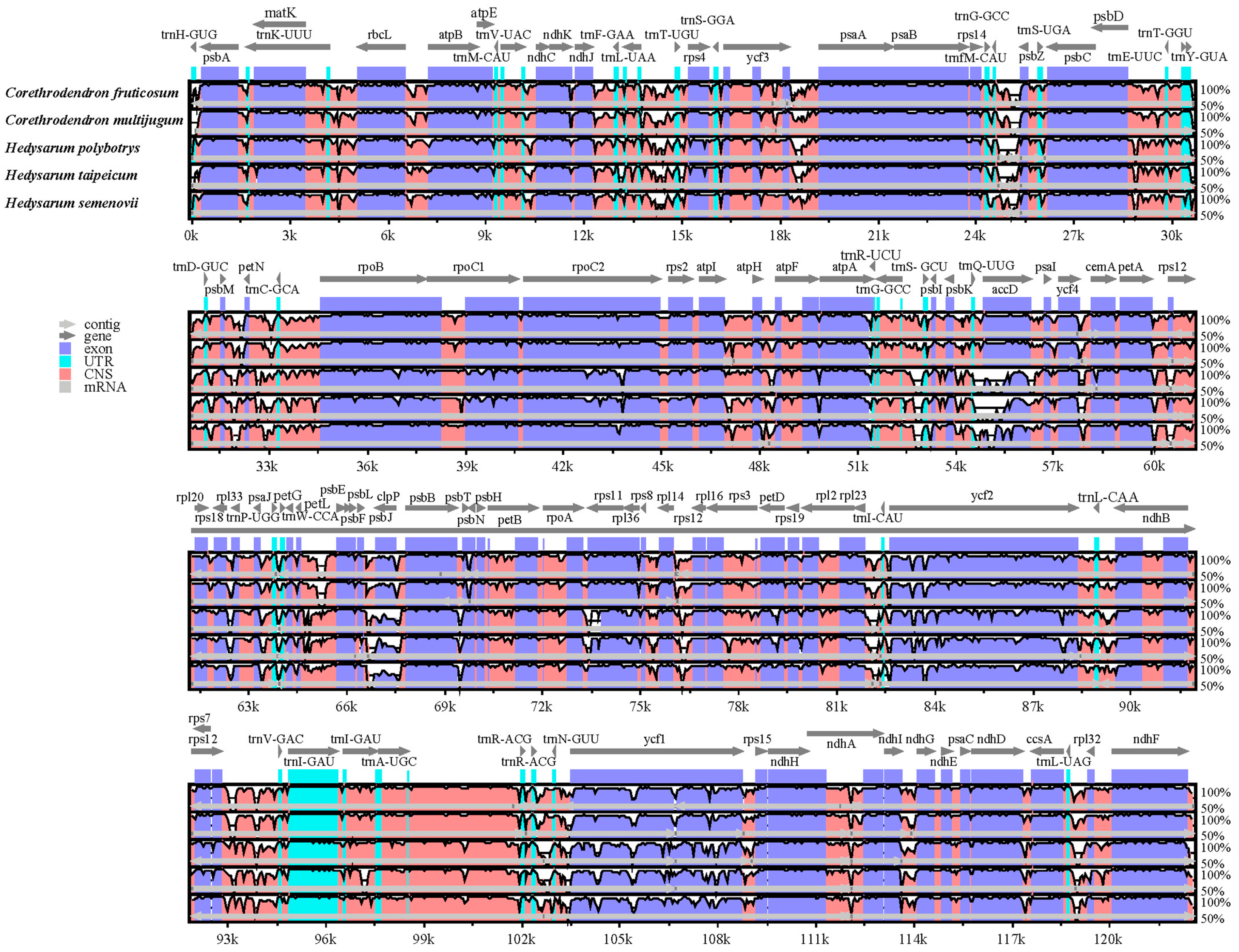Complete Chloroplast Genome of Corethrodendron fruticosum (Papilionoideae: Fabaceae): Comparative and Phylogenetic Analysis
Abstract
1. Introduction
2. Materials and Methods
2.1. DNA Extraction and Sequencing, Genome Assembly, and Annotation
2.2. Identification of Repetitive Sequences and SSRs
2.3. Analysis and Comparison of Genome Structures
2.4. Phylogenetic Analysis
3. Results
3.1. Genomic Characteristics of the C. fruticosum Chloroplast Genome
3.2. Codon Usage Analysis of Protein-Coding Genes
3.3. Repeat Analysis
3.4. Comparative Analysis of the C. fruticosum Chloroplast Genome
3.5. Phylogenetic Analysis
4. Discussion
4.1. Sequence Variation in C. fruticosum
4.2. Repeat Sequences
4.3. Phylogeny of C. fruticosum
5. Conclusions
Supplementary Materials
Author Contributions
Funding
Institutional Review Board Statement
Informed Consent Statement
Data Availability Statement
Conflicts of Interest
References
- Xu, L.R.; Choi, B.H. Hedysarum L. In Flora of Chinal; Wu, Z.Y., Raven, P.H., Hong, D.Y., Eds.; Science Press: St. Louis, MO, USA; Botanical Garden Press: Beijing, China, 2010; Volume 10, pp. 514–525. [Google Scholar]
- Yan, G.; Huang, Z. A Study of Biological Character for Seeds and Seedling of Hedysarum laeve and H. scoparium. Grassl. China 1996, 3, 37–41. [Google Scholar]
- Li, S.; Li, Q.; Cui, Z. Determination of Optimum Condition for Seed Germination Testing of Hedysarum Leave. Grassl. China 1995, 4, 52–55. [Google Scholar]
- Huang, J.; Zhang, Y. Main Wind-proof Sand-fixing Plants and Their Application Value. Mod. Agric. Res. 2020, 26, 145–146. [Google Scholar]
- Chen, X.; Gao, Y.; Zhao, N.; Li, W.; Zhang, C.; Zhai, B.; Wang, Y. Adaptation evaluation of saline-alkali condition on roots of Hedysarum laeve in Mu Us sandy lande. J. Northwest A&F Univ. (Nat. Sci. Ed.) 2017, 45, 89–94. [Google Scholar]
- Liu, F.; Ye, X.; Yu, F.; Dong, M. Clonal Integration Modifies Responses of Hedysarum laeve to LOCAL Sand Burial in MU US Sandland. J. Plant Ecol. 2006, 30, 278–285. [Google Scholar]
- Ferguson, I.K.; Skvarla, J.J. Pollen morphology of the subfamily Papilionoideae (Leguminosae). In Advances in Legumes Systematics 1; Royal Botanic Gardens, Kew: Richmond, UK, 1981. [Google Scholar]
- Amirahmadi, A.; Kazempour Osaloo, S.; Moein, F.; Kaveh, A.; Maassoumi, A.A. Molecular systematics of the tribe Hedysareae (Fabaceae) based on nrDNA ITS and plastid trnL-F and matK sequences. Plant Syst. Evol. 2014, 300, 729–747. [Google Scholar] [CrossRef]
- Duan, L.; Wen, J.; Yang, X.; Liu, P.L.; Arslan, E.; Ertuğrul, K.; Chang, Z.Y. Phylogeny of Hedysarum and tribe Hedysareae (Leguminosae: Papilionoideae) inferred from sequence data of ITS, matK, trnL-F and Psba-Trnh. TAXON 2015, 64, 49–64. [Google Scholar] [CrossRef]
- Ravi, V.; Khurana, J.P.; Tyagi, A.K.; Khurana, P. An update on chloroplast genomes. Plant Syst. Evol. 2008, 271, 101–122. [Google Scholar] [CrossRef]
- Xing, S.; Liu, C.J. Progress in Chloroplast Genome Analysis. Prog. Biochem. Biophys. 2008, 35, 21–28. [Google Scholar]
- Sugiura, M. The chloroplast genome. Plant Mol. Biol. 1992, 19, 149–168. [Google Scholar] [CrossRef]
- Sugiura, M.; Hirose, T.; Sugita, M. Evolution and mechanism of translation in chloroplasts. Annu. Rev. Genet. 1998, 32, 437–459. [Google Scholar] [CrossRef] [PubMed]
- Palmer, J.D. Isolation and structural analysis of chloroplast DNA. Methods Enzymol. 1986, 118, 167–186. [Google Scholar]
- Cheng, H.; Li, J.; Zhang, H.; Cai, B.; Mi, L. The complete chloroplast genome sequence of strawberry (Fragaria × ananassa Duch.) and comparison with related species of Rosaceae. PeerJ 2017, 5, e3919. [Google Scholar]
- Asaf, S.; Khan, A.L.; Khan, M.A.; Imran, Q.M.; Lee, I.J. Comparative analysis of complete plastid genomes from wild soybean (Glycine soja) and nine other Glycine species. PLoS ONE 2017, 12, e0182281. [Google Scholar] [CrossRef] [PubMed]
- Cheon, K.S.; Kim, K.A.; Han, J.S.; Yoo, K.O. The complete chloroplast genome sequence of Codonopsis minima (Campanulaceae), an endemic to Korea. Conserv. Genet. Resour. 2017, 9, 541–543. [Google Scholar] [CrossRef]
- Yin, D.; Wang, Y.; Zhang, X.; Ma, X.; He, X.; Zhang, J. Development of chloroplast genome resources for peanut (Arachis hypogaea L.) and other species of Arachis. Sci. Rep. 2017, 7, 11649. [Google Scholar]
- Martin, G.; Rousseau-Gueutin, M.; Cordonnier, S.; Lima, O.; Michon-Coudouel, S.; Naquin, D.; de Carvalho, J.; Aïnouche, M.; Salmon, A.; Aïnouche, A. The first complete chloroplast genome of the Genistoid legume Lupinus luteus: Evidence for a novel major lineage-specific rearrangement and new insights regarding plastome evolution in the legume family. Ann. Bot. Lond. Oup Acad. Press Oxf. Univ. Press 2014, 113, 1197–1210. [Google Scholar] [CrossRef]
- Xiong, Y.; Xiong, Y.; He, J.; Yu, Q.; Zhao, J.; Lei, X.; Dong, Z.; Yang, J.; Peng, Y.; Zhang, X.; et al. The Complete Chloroplast Genome of Two Important Annual Clover Species, Trifolium alexandrinum and T. resupinatum: Genome Structure, Comparative Analyses and Phylogenetic Relationships with Relatives in Leguminosae. Plants 2020, 9, 478. [Google Scholar]
- Saski, C.; Lee, S.B.; Daniell, H.; Wood, T.C.; Tomkins, J.; Kim, H.G.; Jansen, R.K. Complete Chloroplast Genome Sequence of Glycine max and Comparative Analyses with other Legume Genomes. Plant Mol. Biol. 2005, 59, 309–322. [Google Scholar] [CrossRef]
- Magee, A.M.; Aspinall, S.; Rice, D.W.; Cusack, B.P.; Semon, M.; Perry, A.S.; Stefanovic, S.; Milbourne, D.; Barth, S.; Palmer, J.D. Localized hypermutation and associated gene losses in legume chloroplast genomes. Genome Res. 2010, 20, 1700–1710. [Google Scholar] [CrossRef]
- Liu, B.; Duan, N.; Zhang, H.; Liu, S.; Shi, J.; Chai, B. Characterization of the whole chloroplast genome of Caragana microphylla Lam (Fabaceae). Conserv. Genet. Resour. 2016, 8, 371–373. [Google Scholar] [CrossRef]
- Wakasugi, T.; Tsudzuki, J.; Ito, S.; Nakashima, K.; Tsudzuki, T. Loss of all ndh genes as determined by sequencing the entire chloroplast genome of the black pine Pinus thunbergii. Proc. Natl. Acad. Sci. USA 1994, 91, 9794–9798. [Google Scholar] [CrossRef] [PubMed]
- Chumley, T.W.; Palmer, J.D.; Mower, J.P.; Matthew, F.H.; Calie, P.J.; Boore, J.L.; Jansen, R.K. The Complete Chloroplast Genome Sequence of Pelargonium × hortorum: Organization and Evolution of the Largest and Most Highly Rearranged Chloroplast Genome of Land Plants. Mol. Biol. Evol. 2006, 23, 2175–2190. [Google Scholar] [CrossRef]
- Shinozaki, K.; Ohme, M.; Tanaka, M.; Wakasugi, T.; Hayashida, N.; Matsubayashi, T.; Zaita, N.; Chunwongse, J.; Obokata, J.; Yamaguchi-Shinozaki, K. The complete nucleotide sequence of the tobacco chloroplast genome: Its gene organization and expression. EMBO J. 1986, 5, 2043–2049. [Google Scholar] [CrossRef] [PubMed]
- Ohyama, K.; Fukuzawa, H.; Kohchi, T.; Shirai, H.; Sano, T.; Sano, S.; Umesono, K.; Shiki, Y.; Takeuchi, M.; Chang, Z. Chloroplast gene organization deduced from complete sequence of liverwort Marchantia polymorpha chloroplast DNA. Nature 1986, 322, 572–574. [Google Scholar] [CrossRef]
- Hua, Z.; Tian, D.; Jiang, C.; Song, S.; Chen, Z.; Zhao, Y.; Jin, Y.; Huang, L.; Zhang, Z.; Yuan, Y. Towards comprehensive integration and curation of chloroplast genomes. Plant Biotechnol. J. 2022, 20, 2239–2241. [Google Scholar] [CrossRef]
- Memberspartners, C.N.; Gao, F. Database Resources of the National Genomics Data Center, China National Center for Bioinformation in 2022. Nucleic Acids Res. 2021, 50, D27–D38. [Google Scholar]
- She, R.X.; Li, W.Q.; Xie, X.M.; Gao, X.X.; Zhao, P. The complete chloroplast genome sequence of a threatened perennial herb species Taibai sweetvetch (Hedysarum taipeicum K.T. Fu). Mitochondrial DNA Part B 2019, 4, 1439–1440. [Google Scholar] [CrossRef]
- Zhang, R.; Wang, Y.H.; Jin, J.; Stull, G.W.; Anne, B.; Domingos, C.; Paganucci, D.Q.L.; Moore, M.J.; Zhang, S.D.; Chen, S.Y. Exploration of Plastid Phylogenomic Conflict Yields New Insights into the Deep Relationships of Leguminosae. Syst. Biol. 2020, 69, 613–622. [Google Scholar] [CrossRef]
- Cao, J.; Han, C.; Yang, Y. Characterization of the complete chloroplast genome of Hedysarum polybotrys var. alaschanicum (Fabaceae) and its phylogeny. Mitochondrial DNA Part B Resour. 2021, 6, 3312–3313. [Google Scholar] [CrossRef]
- Jin, J.J.; Yu, W.B.; Yang, J.B.; Song, Y.; Li, D.Z. GetOrganelle: A fast and versatile toolkit for accurate de novo assembly of organelle genomes. Genome Biol. 2020, 21, 241. [Google Scholar] [CrossRef] [PubMed]
- Qu, X.J.; Moore, M.J.; Li, D.Z.; Yi, T.S. PGA: A software package for rapid, accurate, and flexible batch annotation of plastomes. Plant Methods 2019, 15, 50. [Google Scholar] [CrossRef] [PubMed]
- Lohse, M.; Drechsel, O.; Bock, R. OrganellarGenomeDRAW (OGDRAW): A tool for the easy generation of high-quality custom graphical maps of plastid and mitochondrial genomes. Curr. Genet. 2007, 52, 267–274. [Google Scholar] [CrossRef] [PubMed]
- Kearse, M.; Moir, R.; Wilson, A.; Stones-Havas, S.; Cheung, M.; Sturrock, S.; Buxton, S.; Cooper, A.; Markowitz, S.; Duran, C.; et al. Geneious Basic: An integrated and extendable desktop software platform for the organization and analysis of sequence data. Bioinformatics 2012, 28, 1647–1649. [Google Scholar] [CrossRef] [PubMed]
- Kurtz, S.; Schleiermacher, C. REPuter: Fast computation of maximal repeats in complete genomes. Bioinformatics 1999, 15, 426–427. [Google Scholar] [CrossRef] [PubMed]
- Sebastian, B.; Thomas, T.; Thomas, M.; Uwe, S.; Martin, M. MISA-web: A web server for microsatellite prediction. Bioinformatics 2017, 33, 2583–2585. [Google Scholar]
- Julio, R.; Albert, F.M.; Carlos, S.D.J.; Sara, G.R.; Pablo, L.; Ramos-Onsins, S.E.; Alejandro, S.G. DnaSP 6: DNA Sequence Polymorphism Analysis of Large Data Sets. Mol. Biol. Evol. 2017, 34, 12. [Google Scholar]
- Stephan, G.; Pascal, L.; Ralph, B. OrganellarGenomeDRAW (OGDRAW) version 1.3.1: Expanded toolkit for the graphical visualization of organellar genomes. Nuclc Acids Res. 2019, 47, W59–W64. [Google Scholar]
- Katoh, K.; Standley, D. MAFFT multiple sequence alignment software version 7: Improvements in performance and usability. Mol. Biol. Evol. 2013, 30, 722–780. [Google Scholar] [CrossRef]
- Posada, D.; Crandall, K.A. MODELTEST: Testing the model of DNA substitution. Bioinformatics 1998, 14, 817–818. [Google Scholar] [CrossRef]
- Lam-Tung, N.; Schmidt, H.A.; Arndt, V.H.; Quang, M.B. IQ-TREE: A Fast and Effective Stochastic Algorithm for Estimating Maximum-Likelihood Phylogenies. Mol. Biol. Evol. 2015, 32, 268–274. [Google Scholar]
- Ronquist, F.; Teslenko, M.; Mark, P.; Ayres, D.L.; Darling, A.; Hhna, S.; Larget, B.; Liu, L.; Suchard, M.A.; Huelsenbeck, J.P. MrBayes 3.2: Efficient Bayesian Phylogenetic Inference and Model Choice Across a Large Model Space. Syst. Biol. 2012, 61, 539–542. [Google Scholar]
- Kikuchi, S.; Imai, M.; Nakahira, Y.; Kotani, Y.; Hashiguchi, Y.; Nakai, Y.; Takafuji, K.; Bédard, J.; Hirabayashi-Ishioka, Y.; Mori, H.; et al. A Ycf2-FtsHi Heteromeric AAA-ATPase Complex Is Required for Chloroplast Protein Import. Plant Cell 2018, 30, 2677–2703. [Google Scholar] [CrossRef] [PubMed]
- Nie, L.; Cui, Y.; Wu, L.; Zhou, J.; Yao, H. Gene Losses and Variations in Chloroplast Genome of Parasitic Plant Macrosolen and Phylogenetic Relationships within Santalales. Int. J. Mol. Sci. 2019, 20, 5812. [Google Scholar] [CrossRef]
- Huang, S.; Ge, X.; Cano, A.; Salazar, B.; Deng, Y. Comparative analysis of chloroplast genomes for five Diclipteraspecies (Acanthaceae): Molecular structure, phylogenetic relationships, and adaptive evolution. PeerJ 2020, 8, e8450. [Google Scholar] [CrossRef]
- Wei, F.; Tang, D.; Wei, K.; Qin, F.; Li, L.; Lin, Y.; Zhu, Y.; Khan, A.; Kashif, M.H.; Miao, J. The complete chloroplast genome sequence of the medicinal plant Sophora Tonkinensis. Sci. Rep. 2020, 10, 12473. [Google Scholar] [CrossRef]
- Hohmann, N.; Wolf, E.M.; Lysak, M.A.; Koch, M.A. A Time-Calibrated Road Map of Brassicaceae Species Radiation and Evolutionary History. Plant Cell 2015, 27, 2770–2784. [Google Scholar] [CrossRef]
- Dong, W.; Liu, J.; Jing, Y.; Wang, L.; Zhou, S. Highly Variable Chloroplast Markers for Evaluating Plant Phylogeny at Low Taxonomic Levels and for DNA Barcoding. PLoS ONE 2012, 7, e35071. [Google Scholar] [CrossRef]
- Cui, N.; Liao, B.S.; Liang, C.L.; Shi-Feng, L.I.; Zhang, H.; Jiang, X.U.; Xi-Wen, L.I.; Chen, S.L. Complete chloroplast genome of Salvia plebeia: Organization, specific barcode and phylogenetic analysis. Chin. J. Nat. Med. 2020, 18, 563–572. [Google Scholar] [CrossRef]
- Sun, Y.; Li, J.; Zhang, L.; Lin, R. Regulation of chloroplast protein degradation. J. Genet. Genom. 2023. [Google Scholar] [CrossRef]
- Sasaki, Y. The compartmentation of acetyl-coenzyme A carboxylase in plants. Plant Physiol. 1995, 108, 445–449. [Google Scholar] [CrossRef]
- Kozaki, A.; Kamada, K.; Nagano, Y.; Iguchi, H.; Sasaki, Y. Recombinant Carboxyltransferase Responsive to Redox of Pea Plastidic Acetyl-CoA Carboxylase. J. Biol. Chem. 2000, 275, 10702–10708. [Google Scholar] [CrossRef]
- Kozaki, A.; Mayumi, K.; Sasaki, Y. Thiol-Disulfide Exchange between Nuclear-encoded and Chloroplast-encoded Subunits of Pea Acetyl-CoA Carboxylase. J. Biol. Chem. 2001, 276, 39919–39925. [Google Scholar] [CrossRef]
- Logemann, E.; Tavernaro, A.; Schulzt, W.G. UV light selectively coinduces supply pathways from primary metabolism and flavonoid secondary product formation in parsley. Proc. Natl. Acad. Sci. USA 2000, 97, 1903–1907. [Google Scholar] [CrossRef] [PubMed]
- Zhang, C.; Yang, C.; Dong, M. The clonal integration of photosynthates in the rhizomatous half-shrub Hedysarum laeve. Acta Ecol. Sin. 2001, 21, 1986–1993. [Google Scholar]
- Li, B.; Zheng, Y. Dynamic evolution and phylogenomic analysis of the chloroplast genome in Schisandraceae. Sci. Rep. 2018, 8, 9285. [Google Scholar] [CrossRef] [PubMed]
- Zhang, S.; Gao, M.; Zaitlin, D. Molecular Linkage Mapping and Marker-Trait Associations with NlRPT, a Downy Mildew Resistance Gene in Nicotiana Langsdorffii. Front. Plant Sci. 2012, 3, 185. [Google Scholar] [CrossRef]
- Breidenbach, N.; Gailing, O.; Krutovsky, K.V. Genetic structure of coast redwood (Sequoia sempervirens [D Don] Endl) populations in and outside of the natural distribution range based on nuclear and chloroplast microsatellite markers. PLoS ONE 2020, 15, e0243556. [Google Scholar] [CrossRef]
- Gichira, A.W.; Avoga, S.; Li, Z.; Hu, G.; Wang, Q.; Chen, J. Comparative genomics of 11 complete chloroplast genomes of Senecioneae (Asteraceae) species: DNA barcodes and phylogenetics. Bot. Stud. 2019, 60, 17. [Google Scholar] [CrossRef]
- Yang, L.; Zhao, H.; Peng, Z.; Dong, L.; Gao, Z. Development and Application of SSR Molecular Markers from the Chloroplast Genome of Bamboo. J. Trop. Subtrop. Bot. 2014, 22, 263–269. [Google Scholar]
- Lei, W.; Ni, D.; Wang, Y.; Shao, J.; Chang, L. Intraspecific and heteroplasmic variations, gene losses and inversions in the chloroplast genome of Astragalus membranaceus. Sci. Rep. 2016, 6, 21669. [Google Scholar] [CrossRef] [PubMed]
- Wojciechowski, M.F.; Lavin, M.; Sanderson, M.J. A phylogeny of Legumes (leguminosae) based on analysis of the plastid matk gene resolves many well-supported subclades within the family. Am. J. Bot. 2004, 91, 1846–1862. [Google Scholar] [CrossRef] [PubMed]
- Wojciechowski, M.F.; Sanderson, M.J.; Steele, K.P.; Liston, A. Molecular phylogeny of the “temperate herbaceous tribes” of papilionoid legumes: A supertree approach. Adv. Legume Syst. 2000, 9, 277–298. [Google Scholar]
- Choi, B.H.; Ohashi, H. Generic criteria and an infrageneric system for Hedysarum and related genera (Papilionoideae-Leguminosae). TAXON 2003, 52, 567–576. [Google Scholar] [CrossRef]
- Tian, C.; Li, X.; Wu, Z.; Li, Z.; Hou, X.; Li, F.Y. Characterization and Comparative Analysis of Complete Chloroplast Genomes of Three Species from the Genus Astragalus (Leguminosae). Front. Genet. 2021, 12, 705482. [Google Scholar] [CrossRef] [PubMed]







| Gene Category | Gene Group | Gene Names |
|---|---|---|
| Photosynthesis | Subunits of Photosystem I | psaA, psaB, psaC, psaI, psaJ |
| Subunits of Photosystem II | psbA, psbB, psbC, psbD, psbE, psbF, psbH, psbI, psbJ, psbK, psbM, psbN, psbT, psbZ | |
| NDH complex | ndhA *, ndhB *, ndhC, ndhD, ndhE, ndhF, ndhG, ndhH, ndhI, ndhJ, ndhK | |
| Subunits of cytochrome b/f complex | petA, petB *, petD *, petG, petL, petN | |
| Subunits of ATP synthase | atpA, atpB, atpE, atpF*, atpH, atpI | |
| Subunits of Rubisco | rbcL | |
| Transcription | Large subunits of ribosomes | rpl14, rpl16, rpl2 *, rpl20, rpl23, rpl32, rpl33, rpl36 |
| Small subunits of ribosomes | rps11, rps12 *, rps14, rps15, rps18, rps19, rps2, rps3, rps4, rps7, rps8 | |
| DNA-dependent RNA polymerase | rpoA, rpoB, rpoC1 *, rpoC2 | |
| rRNA genes | rrn16S, rrn23S, rrn4.5S, rrn5S | |
| tRNA genes | trnA-UGC *, trnC-GCA, trnD-GUC, trnE-UUC, trnE-UUC *, trnF-GAA, trnG-GCC, trnH-GUG, trnK-UUU *, trnL-CAA, trnL-UAA *, trnL-UAG, trnM-CAU(3), trnN-GUU, trnP-UGG, trnQ-UUG, trnR-ACG, trnR-UCU, trnS-GCU, trnS-GGA, trnS-UGA, trnT-CGU *, trnT-GGU, trnT-UGU, trnV-GAC, trnW-CCA, trnY-GUA | |
| Other genes | C-type cytochrome synthesis genes | ccsA |
| Envelope membrane proteins | cemA | |
| Proteases | clpP | |
| Subunits of acetyl-CoA carboxylase | accD | |
| Maturases | matK | |
| Components of the translocon | ycf2 * | |
| Unknown | Conserved open reading frames | ycf3 **, ycf4 |
| Gene | Strand | Start | End | Exon I (bp) | Intron I (bp) | Exon II (bp) | Intron II (bp) | Exon III (bp) |
|---|---|---|---|---|---|---|---|---|
| atpF | − | 54,104 | 55,196 | 172 | 685 | 407 | ||
| ndhA | − | 113,391 | 115,680 | 553 | 1198 | 539 | ||
| ndhB | + | 11,627 | 13,789 | 721 | 678 | 764 | ||
| petD | − | 30,512 | 31,706 | 8 | 712 | 475 | ||
| petB | − | 31,901 | 33,335 | 6 | 787 | 642 | ||
| rpl2 | + | 21,974 | 23,497 | 397 | 696 | 431 | ||
| rpoC1 | − | 63,215 | 66,006 | 430 | 737 | 1625 | ||
| rps12 | − | 10,591 | 43,117 | 114 | 258 | |||
| ycf2 | − | 14,983 | 19,560 | 2711 | 30 | 1837 | ||
| ycf3 | − | 85,395 | 87,263 | 124 | 714 | 236 | 787 | 132 |
| trnT-CGU | + | 51,384 | 52,138 | 35 | 677 | 43 | ||
| trnL-UAA | + | 90,065 | 90,571 | 35 | 422 | 50 | ||
| trnK-UUU | + | 99,750 | 102,272 | 37 | 2451 | 35 | ||
| trnE-UUC | − | 5824 | 6855 | 32 | 960 | 40 | ||
| trnA-UGC | − | 4918 | 5759 | 37 | 805 | 36 |
| Codon | Count | Codon | Count | Codon | Count | Codon | Count |
|---|---|---|---|---|---|---|---|
| TAA | 41 | GGC | 119 | ATG | 470 | AGT | 325 |
| TAG | 16 | GGG | 212 | AAC | 192 | TCA | 263 |
| TGA | 17 | GGT | 525 | AAT | 702 | TCC | 207 |
| GCA | 332 | CAC | 94 | CCA | 252 | TCG | 160 |
| GCC | 179 | CAT | 378 | CCC | 151 | TCT | 420 |
| GCG | 117 | ATA | 549 | CCG | 90 | ACA | 313 |
| GCT | 555 | ATC | 312 | CCT | 338 | ACC | 168 |
| TGC | 52 | ATT | 911 | CAA | 558 | ACG | 100 |
| TGT | 182 | AAA | 762 | CAG | 150 | ACT | 443 |
| GAC | 140 | AAG | 212 | AGA | 308 | GTA | 443 |
| GAT | 607 | CTA | 281 | AGG | 111 | GTC | 124 |
| GAA | 755 | CTC | 122 | CGA | 273 | GTG | 134 |
| GAG | 237 | CTG | 121 | CGC | 71 | GTT | 422 |
| TTC | 339 | CTT | 426 | CGG | 77 | TGG | 342 |
| TTT | 794 | TTA | 722 | CGT | 263 | TAC | 124 |
| GGA | 587 | TTG | 446 | AGC | 74 | TAT | 588 |
| Species | Total SSRs | Compounds SSRs | Type | |||||
|---|---|---|---|---|---|---|---|---|
| Mono- | Di- | Tri- | Tetra- | Penta- | Hexa- | |||
| C. fruticosum | 63 | 8 | 45 | 3 | 3 | 12 | 0 | 0 |
| C. multijugum | 59 | 7 | 43 | 3 | 4 | 9 | 0 | 0 |
| H. semenovii | 68 | 10 | 50 | 1 | 6 | 11 | 0 | 0 |
| H. taipeicum | 80 | 16 | 59 | 2 | 4 | 11 | 1 | 3 |
| H. semenovii | 88 | 16 | 60 | 5 | 12 | 8 | 0 | 3 |
| H. petrovii | 76 | 14 | 56 | 1 | 6 | 12 | 1 | 0 |
Disclaimer/Publisher’s Note: The statements, opinions and data contained in all publications are solely those of the individual author(s) and contributor(s) and not of MDPI and/or the editor(s). MDPI and/or the editor(s) disclaim responsibility for any injury to people or property resulting from any ideas, methods, instructions or products referred to in the content. |
© 2023 by the authors. Licensee MDPI, Basel, Switzerland. This article is an open access article distributed under the terms and conditions of the Creative Commons Attribution (CC BY) license (https://creativecommons.org/licenses/by/4.0/).
Share and Cite
Niu, T.; Tian, C.; Yang, Y.; Liu, Q.; Liu, L.; Tao, Q.; Li, Z.; Wu, Z. Complete Chloroplast Genome of Corethrodendron fruticosum (Papilionoideae: Fabaceae): Comparative and Phylogenetic Analysis. Genes 2023, 14, 1289. https://doi.org/10.3390/genes14061289
Niu T, Tian C, Yang Y, Liu Q, Liu L, Tao Q, Li Z, Wu Z. Complete Chloroplast Genome of Corethrodendron fruticosum (Papilionoideae: Fabaceae): Comparative and Phylogenetic Analysis. Genes. 2023; 14(6):1289. https://doi.org/10.3390/genes14061289
Chicago/Turabian StyleNiu, Tianxiu, Chunyu Tian, Yanting Yang, Qian Liu, Lemeng Liu, Qibo Tao, Zhiyong Li, and Zinian Wu. 2023. "Complete Chloroplast Genome of Corethrodendron fruticosum (Papilionoideae: Fabaceae): Comparative and Phylogenetic Analysis" Genes 14, no. 6: 1289. https://doi.org/10.3390/genes14061289
APA StyleNiu, T., Tian, C., Yang, Y., Liu, Q., Liu, L., Tao, Q., Li, Z., & Wu, Z. (2023). Complete Chloroplast Genome of Corethrodendron fruticosum (Papilionoideae: Fabaceae): Comparative and Phylogenetic Analysis. Genes, 14(6), 1289. https://doi.org/10.3390/genes14061289






